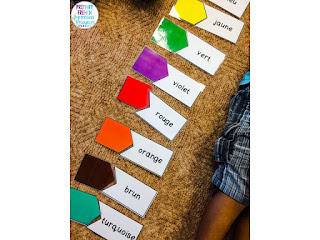I LOVE using centres with my students! My students love them, and will choose many of the centres to play during indoor recess instead of lego and other toys. It rained this week and one of my boys chose to build with magnets on cookie trays!
Setting clear routines is the most important part. Take the time to teach the games to your students so that they understand how to play properly. If they haven't mastered the French vocab, then you will have behavioural and focus issues come up. With younger students, make sure you practice the game as a whole class many times before you introduce it as a centre.
Set-up:
I use the cards from my "j'ai fini" board as the centre rotation cards, as the centres are all things they can also choose to do if they finish their work early. I recently updated the file to include centre group cards, so you can write their names on the group # cards to set up your groups before they come to class.
Normally my "j'ai fini" board is set up like this:
Since they're on magnets, it's really easy to move them over to the other side of my whiteboard to set up the centres.
I line them up vertically and put the group # cards beside them. I have each centre set up on a table group (except bug in a rug, they play on the carpet). I review the rules of each centre with them, and the CLEAN UP rules. We talk about what each centre should look like when it's been properly cleaned up.
They get started at their centres, and I work with my small group at my table. When I'm done with them (about 10 minutes) I ding my bell. This means clean up and come back to the carpet. Once they're all back at the carpet, we look around to check that the room is cleaned up properly. Any groups who wrote on whiteboards are able to read a sentence they wrote to the class. This is our sharing centre.
Then I move the centre cards on the whiteboard down one spot, and tell each group where they are going for their next centre.
Here are some of the centres I do:
1. Bang game:
Put all the vocab you’re practicing in a container. Students pull out a
card. If they can say it in French (or use it in a sentence, to make it harder)
then they can keep the card. If they pull a card that says “bang” then they get
another turn (or lose all their cards, your choice!) You can use any empty yogurt container or plastic tupperware. Just make sure they can't see through the container!
Some of my students like to play bang and then write the words they won on a whiteboard!
2. Bug in a rug: Lay out the vocab in a grid.
One student hides the “bug” under a card, while the other students close their
eyes. They guess in French which vocab card it’s hidden under. Whoever finds the bug gets to hide it next. This game requires an honest conversation with your students about why cheating will ruin the fun of the game!
3. Go fish: You can print any of the flashcards you're using in class. Copy them 2 or 4 per page to make them smaller.
4. Word building: Magnets on cookie trays! My students use our visual dictionaries or word wall strips to choose their words/sentences to build.
These awesome magnets come from wintergreen. This set is much cheaper, but you'd likely need multiple sets. The cookie trays are from the dollar store. Ideally you want small magnets so they can fit more words on the cookie tray.
5. Sentence building: Print squares with a
variety of sentence starters, numbers, colours, and objects. Students then put the words in order to build sentences. You can extend this by having them read their sentences to a partner, or write their sentences on a whiteboard/in their journals.
6. "Pictionary": One student draws on a
whiteboard, the other student has to guess what they are drawing.
7. Matching: Picture to the word. My students use our visual dictionaries to check their work over when they're done!
8. Cootie catchers/fortune tellers with a partner.
9. Bingo - 1 group member can be the bingo caller, others put tokens on the words that are called. I use these as the bingo tokens.
10. Writing on whiteboards -
11. Hunting for sight words -
12. Cube game - Roll the cube and answer the question. Extension - write the question!
I bought the cubes here, and write different prompts on sticky notes to slide under the plastic.
13. SMACK game - One student says the word, whoever smacks it first gets to say the next word!
14. Spin and graph sight words -
15. Stamp the sight words, themed vocab, or sentences!
16. Write the sight words - I bought salt from the dollar store and added a few drops of food colouring, then gave it a good shake. Students use a sharp pencil to write words in the salt!
17. Read and clip -
18. Spinner games - I use these in centres to give my students prompts for oral communication or writing. They can spin the spinner and either say a sentence or write a sentence. They can review vocabulary in partners (one spins, one says the word).
19. Working with Mlle - The BEST part about centres is that it means I can pull small groups to work with.
Do you have any centres you love? Feel free to share in the comments :)





























































